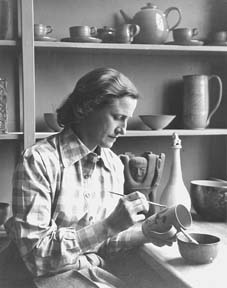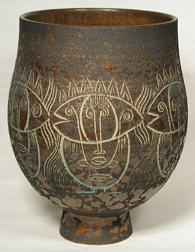|
Edwin & Mary Scheier
Mary Scheier
1908-2007
 Potter Mary Scheier died May 14, 2007, at age 99 in Green Valley, AZ. She was internationally known for her superbly thrown pottery vessels. She and her husband Edwin’s New Hampshire connection has ensured a rich legacy to the state. They taught pottery at the University of New Hampshire for nearly 30 years before making Arizona their home. The University of NH Special Collections has important holdings of their work. The Scheiers gave their personal collection to the Currier Museum of Art. Potter Mary Scheier died May 14, 2007, at age 99 in Green Valley, AZ. She was internationally known for her superbly thrown pottery vessels. She and her husband Edwin’s New Hampshire connection has ensured a rich legacy to the state. They taught pottery at the University of New Hampshire for nearly 30 years before making Arizona their home. The University of NH Special Collections has important holdings of their work. The Scheiers gave their personal collection to the Currier Museum of Art.
In 2003, the Scheiers were designated Lotte Jacobi Living Treasures at the NH Governors Arts Awards. To mark the occasion, Currier Museum of Art Director Susan Strickler presented to the State of New Hampshire a stoneware vase that was created by the Scheiers in 1966. Their most recent NH recognition was awarded last week on May 10th when they received the Lifetime Achievement Award from the League of New Hampshire Craftsmen.
Born Mary Goldsmith in 1908 in Salem, VA, Mary Scheier studied art in New York City in the late 1920s at Grand Central School of Art, the Art Students League, and the New York School of Fine and Applied Arts.
In 1935 she was appointed director of Big Stone Gap and Abingdon Art Centers, the first Federally sponsored art galleries in Virginia. There, in 1937 she met her future husband Edwin Scheier, who was then Field Supervisor of the Federal Art Project in Kentucky, Virginia and North Carolina. They married August 19, 1937, and embarked upon a career together making pottery.
 In 1939 the Scheiers set up their first studio, Hillcrock Pottery, in Glade Spring, VA, making small sculptures and functional pottery using local clays. The next year, they won second prize in ceramics at the Ninth Annual Ceramic National Exhibition at Syracuse Museum of Fine Arts (now the Everson Museum). This was the first of many prestigious national awards. Essentially self-taught potters, this devoted couple who collaborated on the production of functional pots for many decades rose to become major figures in the studio pottery movement within a few years. Mary Scheier became expert in throwing thin-walled vessels while Ed became noted for his imaginative surface decorations and glazing. In 1939 the Scheiers set up their first studio, Hillcrock Pottery, in Glade Spring, VA, making small sculptures and functional pottery using local clays. The next year, they won second prize in ceramics at the Ninth Annual Ceramic National Exhibition at Syracuse Museum of Fine Arts (now the Everson Museum). This was the first of many prestigious national awards. Essentially self-taught potters, this devoted couple who collaborated on the production of functional pots for many decades rose to become major figures in the studio pottery movement within a few years. Mary Scheier became expert in throwing thin-walled vessels while Ed became noted for his imaginative surface decorations and glazing.
They were invited to teach at University of New Hampshire by David R. Campbell, director of the League of NH Craftsmen. The Scheiers lived, worked and taught in Durham from 1940 until 1968, when they moved to Oaxaca, Mexico. In 1978 the Scheiers moved to Green Valley, Arizona, where they have lived ever since.
The pottery of Mary and Edwin Scheier is in museum collections across the country, including the American Craft Museum, the Everson Museum of Art, the Metropolitan Museum of Art, the Newark Museum, the Ceramic Research Center in Tempe, AZ, the Cranbrook Academy of Art Museum, and the Currier Museum of Art in Manchester.
In 2001 Ken Browne Productions released a film on the Scheiers entitled Four Hands, One Heart that aired nationally on many public television stations. Mary Scheier is survived by her husband of 69 years, Edwin Scheier.
Photo caption: Stoneware Vase by Edwin and Mary Scheier, Lotte Jacobi Living Treasure honorees at the 2003 Governors Arts Awards. Photo by Gary Samson
<go to top>
Ed Scheier
1911 - 2008
New Hampshire has lost one of its greatest craftsmen. Renowned potter Ed Scheier, who helped launch the studio pottery movement from his post as a young professor at the University of New Hampshire, died Sunday in Green Valley, Ariz., where he had lived for the past 30 years. He was 97.
Scheier, a small man with a wry sense of humor that friends say made him instantly likeable, was best known in the art world for his decorating techniques. His pots are large and feature designs that tell stories of mothers and children, Adam and Eve, birth and love. The last theme is important; friends say it's impossible to talk about Ed without talking about his wife, Mary, also a potter and known for her elegant forms. She died last year, at the age of 99.
Their legacy is a shared one, which seems to be just the way the Scheiers would have wanted it. Together, they nurtured the mid-century evolution of studio pottery from everyday craft to fine art.
"Their legacy is one of imbuing the potter's life with a sense of seriousness, purposefulness, high standards and great creativity," said Susan Strickler, the director of the Currier Museum of Art in Manchester and a friend of the Scheiers. "(Ed) was not just a good craftsman, but someone who had a very lively creative mind, and that was exemplified in New Hampshire in the pottery he made."
Scheier was born in the Bronx in 1910 to German immigrant parents. He didn't finish high school, Strickler said, and later mused privately about how he'd become a university professor without a diploma of his own. In the introduction to a recent documentary about Scheier and his wife called Four Hands One Heart, Scheier describes their life as "a whole succession of pure lucky breaks."
Scheier was introduced to art as a young man through a few low-level apprenticeships with New York artists, Strickler said. In 1935, he attended the New York School of Industrial Arts and a few years later, landed a job with the Federal Art Project of the New Deal's Works Progress Administration.
It was through that job that he met Mary in 1937. He was a coordinator who made the rounds to federally funded southern art galleries. She was the director of such a gallery in Big Stone Gap, Va.
They were married within a year and hit the road for a brief stint as puppeteers, sometimes bartering entertainment for food. By 1938, they had taken more steady jobs managing an industrial kiln for the Tennessee Valley Authority project. The Scheiers were allowed to use the kiln during their time off, and in 1939, left their jobs to set up their own pottery shop in an old log cabin in Glade Spring, Va.
Entirely self-taught, they made what Strickler described as functional pieces. They won praise almost immediately. In 1940, they won second prize in a national ceramics exhibition in New York.
About the same time, they met David Campbell, an early leader of the League of New Hampshire Craftsmen. He encouraged the couple to move to New Hampshire and found Scheier a teaching post at UNH, where the arts department was on the brink of a transformation. From 1940 to 1960, Scheier taught and his wife served as an artist-in-residence, sometimes creating up to 200 pieces a day.
Vicki Wright, director of The Art Gallery at UNH, said the Scheiers helped put UNH's arts department on the map. As pioneers in the studio pottery movement, "they brought international attention to New Hampshire because they were here, living and working," Wright said.
They also made an impact on their students. A search of the UNH Archives revealed an anecdote from an anonymous student in one of Scheier's pottery classes. The student recalled that one day, Scheier told them they were going to dig for clay in the pits behind the outdoor swimming pool.
"Mr. Scheier gleefully provided us with an array of funny-looking accessories. At 103 lbs., 5'3", I was the smallest, so he had me wear a pair of yellow slicker trousers with suspenders that would have fit a man of 300 pounds, plus he had me carry a shovel with an eight-foot handle," the student recalled.
He gave the rest of the students similarly silly gear, handed out several five-gallon jars and marched the class through the center of campus, the student said. "When we finally got to the clay pits, he announced that we were not actually going to dig any clay!," the student said. "The pick, shovels and slickers were just to attract attention, for the profile. And the glass jars? 'To catch frogs!' "
In 1968, the Scheiers moved to Oaxaca, Mexico, where Ed Scheier began experimenting with weavings, paintings and carved wood sculptures, Strickler said. Ten years later, they settled in Green Valley, Ariz. and Scheier returned to pottery, making some of his biggest and best-known pieces.
They came back to New Hampshire several times for exhibitions of their works, gallery dedications and arts events. Wright remembers the couple as warm, generous and creative. She also recalled Scheier's dry wit. Strickler, who visited the couple several times in Arizona, said Scheier was known for telling tall tales with a straight face. He'd talk about running into bandits while exploring in Mexico. Once, a child asked the couple where their children were and Scheier said he'd lost them in a pot.
The Scheiers never had children but, as friends point out, they had each other. The couple worked side by side, sometimes on the same project and sometimes not, for their entire careers.
In 1999, Ed Scheier's art took another turn. Concerned about his health, his doctors told him to stop throwing pots. So at 89, Scheier taught himself a new medium: what he called "computer painting." Until about a year ago, he created striking digital images based on the themes of his earlier work.
"He was constantly learning new things, constantly experimenting," Strickler said.
It was only in the last few weeks before his death, she said, that he wasn't thinking about his art
<go to top>
back to "In Memory" main page
Last
updated:
February 12, 2015
|

